Ants collected in Mkomazi Game Reserve, Tanzania, by G McGavin, 1995-97
| The Ants of Africa Ants collected in Mkomazi Game Reserve, Tanzania, by G McGavin, 1995-97 |
The Mkomazi Game Reserve is located in north-east Tanzania and lies adjacent to the Kenyan border and the Tsavo (West) National Park. It covers an area of circa 3250 km2 with geographical borderlines of 37°35'-38°45' E and 3°50'-4°25' S. The area is part of the East African high plateau, with an altitude varying between 240 and 1609 m a.s.l. The climate is semi-arid (Coe, 1995) with a pronounced dry season and high mean temperatures between 23.1 and 37.8 °C. Precipitation ranges from 300 mm in the eastern part to 900 mm in the central and western parts of the reserve and shows a bimodal distribution, with the long rainy season between March and mid-May and the short rainy season between late October and December. The habitat is wooded grassland on the plains and woodland on the top of most hills; the most common tree species belong to the genera Senegalia (mostly muli-stemmed shrubs) or Vachellia (the flat-topped tree forms) [former Acacia] and Commiphora.
Insect sampling and analysis. Trees (see list at the bottom) were sampled during visits by the Dr George McGavin in April 1995, December 1995-January 1996, March-April 1996, and January 1997. Samples were taken using a "Hurricane Minor" petrol-driven mist blower (Cooper-Pegler Ltd), with an ultra-low-volume delivery nozzle. A mist of undiluted Pybuthrin 216. a pyrethroid formulation synergised with piperonyl butoxide. was sprayed into the canopy in still conditions with dry leaf surfaces. Only trees under 10m high were sprayed and spraying time was 30 s, with three bursts from different directions. After a standard drop-time of 1 h, insects were collected in 1-m2 funnel-shaped trays. Catches were brushed into collecting jars, separated from debris and plant material and stored in 70% alcohol. All trays put under one tree were lumped to form a sample.
To avoid a proliferation of references the early taxonomic literature is not cited here. TL = total length from apex of gaster (abdomen) to the frontal margin of the head, excluding the mandibles.
Ant species from Mkomazi
|
Subfamily Dolichoderinae |
||
| Tapinoma danitschi Forel | Minute soft-bodied ant, TL 1.5 mm First report from Tanzania; type location Kenya, Fundu Island on Lannea schweinfurthii (Tree 3/66) |
 |
| Tapinoma
demissum Forel |
Very small soft-bodied ant, TL 2.0 mm Type location Zimbabwe Single finding of one specimen on Dicrostachys cinerea (Tree 2/34) |
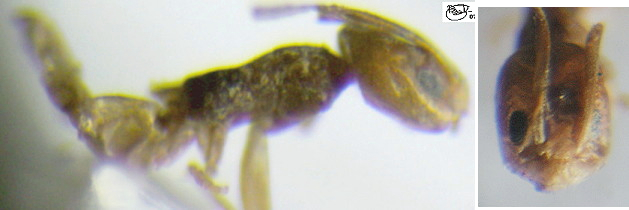 |
| Tapinoma minimum Mayr | Minute soft-bodied ant, TL 1.2-1.4 mm Type location Tanzania, Tanga Four findings, two on Vachellia nilotica (Trees 5/55/ & 5/63), 1 & 4 specimens; one on Vachellia zanzibarica (Tree 5/28), 1 specimen; and, one on Combretum molle (Tree 2/31) single specimen |
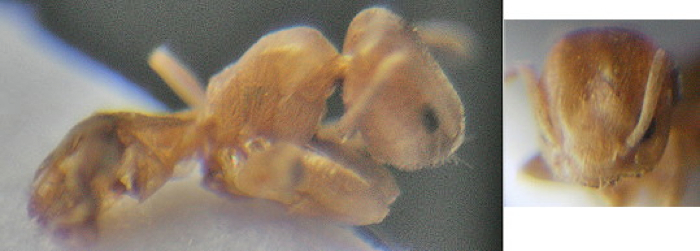 |
| Tapinoma modestum Santschi | Minute soft-bodied ant, TL 1.4-1.5 mm First report from Tanzania; type location Zimbabwe. three findings; one on Vachellia nilotica (Tree 5/56), 2 specimens; two on Lannae schweinfurthii (Trees 3/66 & 3/67) many & 23 specimens |
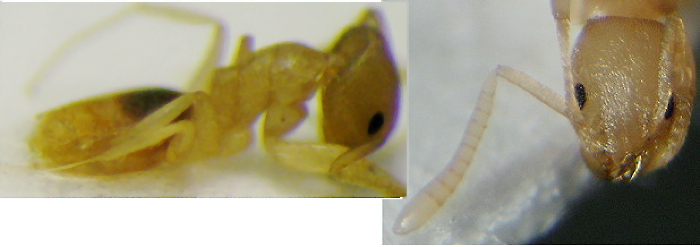 |
| Tapinoma schultzei (Forel) | Very small soft-bodied ant, TL 2.0 mm Known from Tanzania but diagnosis questionable as, like all Tapinoma the specimens crush as they dry out. Two findings; one on Vachellia zanzibarica (Tree 5/17), 3 specimens; and one on Combretum molle (Tree 3/65), 1 specimen |
 |
| Tapinoma possible new species T. mcgavini Tanzania 2/18 | Minute soft-bodied ant, TL 1.5 mm; on Combretum molle (Tree 2/18) |  |
| Tapinoma possible new species Tanzania 3/68/07 | Minute soft-bodied ant, TL ca 1.5 mm; on Terminalia brownii (Tree 3/68), 1 specimen |  |
| Technomyrmex pallipes (F Smith) | Small ant, TL 2.4-2.5 mm Type location Kenya; also from Tanzania; Mkomazi Game Reserve, 3°54.75' S 37°48.58' E, pkd collection from Vachellia zanzibarica (Tree 5/28) |
 |
| Technomyrmex vapidus Bolton | Small ant, TL 2.4-2.5 mm Type location Kenya; also from Tanzania; single dealate queen & 3 workers on two different trees one on Dichrostachys cinerea (Tree 2/37), one queen; and, one on Lannea schweinfurthii (Tree 3/66) 4 specimens |
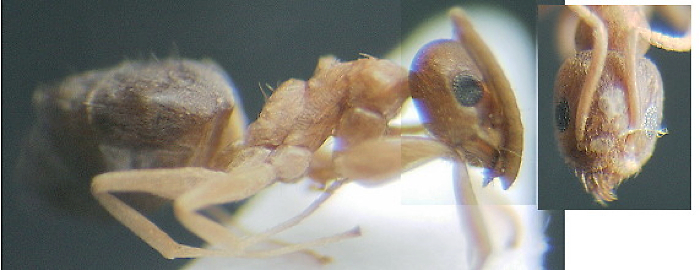 |
|
Subfamily Formicinae |
||
| Camponotus (Myrmacrhaphe) rotundinodis Santschi | Medium sized ant, TL 4.2 mm First record for Tanzania; prior records from Uganda & Zaïre, new senior synonym of Camponotus tameri (Weber) from Sudan One specimen on Vachellia zanzibarica (Tree 5/17) |
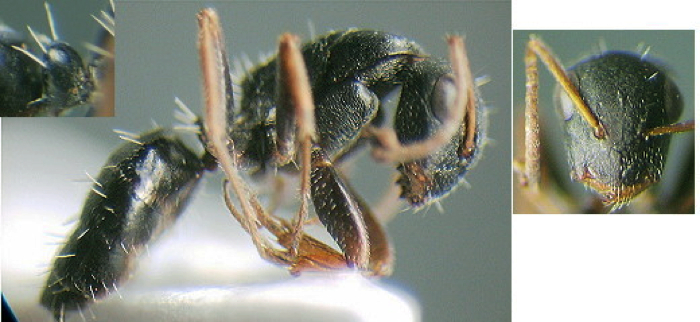 |
| Camponotus (Myrmisolepis) erinaceus Gerstäcker | Medium sized ant, minor TL 6.7 mm Type location Arusha, Tanzania One finding of 3 specimens on Heywoodia lucens (Tree 3/51) |
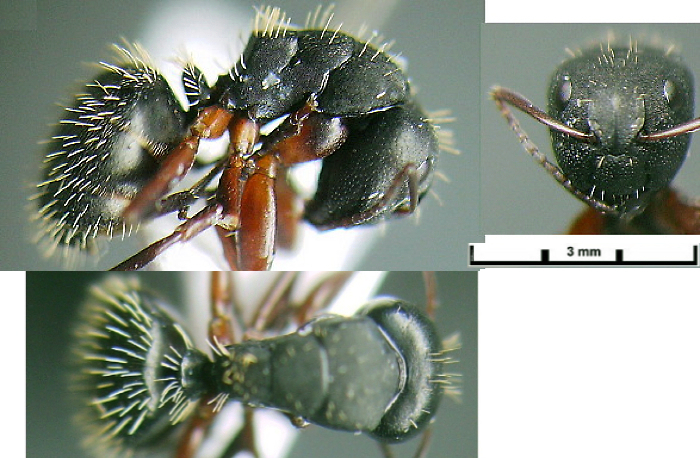 |
| Camponotus (Myrmisolepis) braunsi Mayr | Medium sized ant, minor TL 4.5 mm, major TL 8 mm Wide ranging in East Africa, Mozambique to Somalia One finding of 17 specimens on Vachellia nilotica (Tree 5/64) |
 |
| Camponotus (Myrmopelta) kollbrunneri (Forel) | Medium sized ant, minor not described, major TL
8.0 mm First report from Tanzania; type location Ethiopia One finding on Heywoodia lucens (Tree 3/50), 4 specimens |
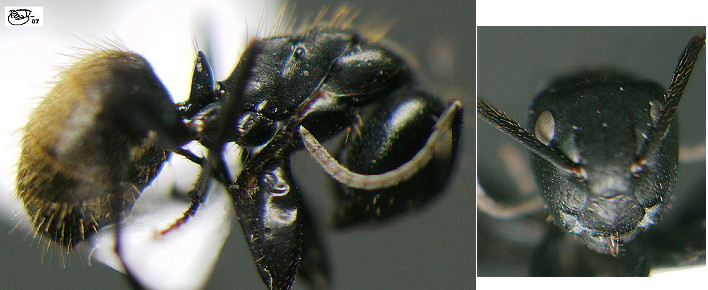 |
|
Camponotus (Myrmosaga) mombassae Forel - revived status |
Medium sized ant, major (?) TL 5.6 mm First report from Tanzania; previously known only from holotype worker from Mombasa, Kenya One finding of 3 workers on Ochna holstii (Tree 3/56) |
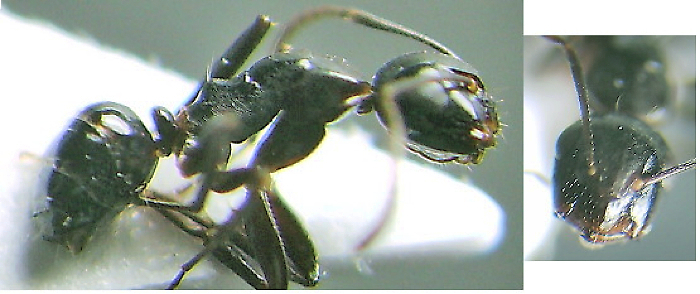 |
| Camponotus (Myrmosericus) flavomarginatus Mayr | Large ant, minor TL ca 6 mm, major TL 9 mm First report from Tanzania; widespread across sub-Saharan Africa. Known as a quite common ground-nesting species that forages on trees Five findings - 3 on Vachellia zanzibarica (Trees 5/16, 5/17 & 5/28), 19-46 specimens; 1 on Grewia sp (Tree 2/15), 1 specimen; 1 on Terminalia brownii (Tree 3/68), 6 specimens |
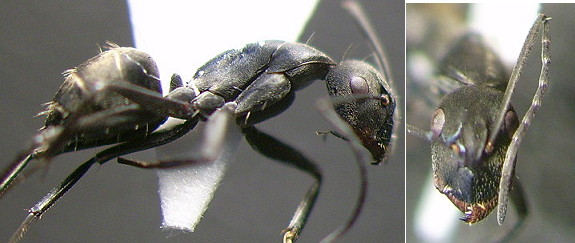 |
| Camponotus (Myrmotrema) ilgii Forel | Medium sized ant, major-media TL 4.2-4.7 mm Single dealate queen only; first report from Tanzania; earlier reports from spines of Vachellia seyal fistula Schwf. and Vachellia bussei Harms One finding, single specimen on Ochni holstii (Tree 3/56) |
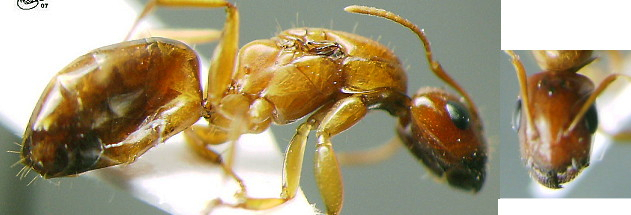 |
| Camponotus (Myrmotrema) robecchii Emery | Medium sized ant, major-media TL 4.0-5.8 mm First report from Tanzania; widespread in eastern Africa Four findings; three on Vachellia zanzibarica, 1-3 specimens; one on Terminalia brownii, 1 specimen |
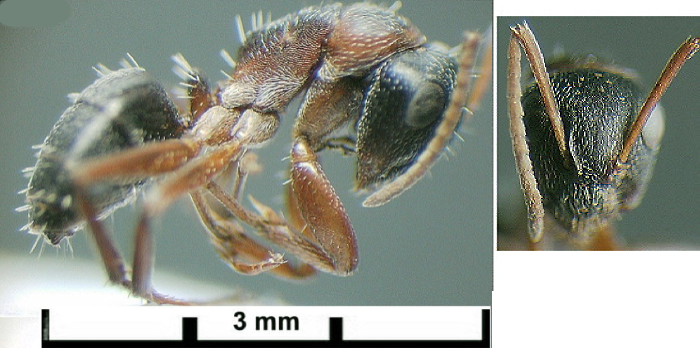 |
| Camponotus (Orthonotomyrmex) sericeus Fabricius | Medium sized ant, minor TL 6-8.2 mm, major TL
8.0-10 mm Common pan-African species; ground-nesting and foraging Single finding, one specimen on Dicrostachys cinerea (Tree 2/34) |
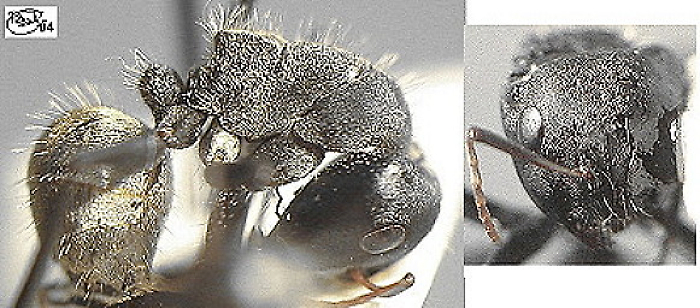 |
| Camponotus (Tanaemyrmex) minusculus (Viehmeyer) - new status | Medium sized ant, major-media TL 6.0-8.5 mm Type location Tanzania, Manow, Bez. [District] Langenburg (southwest Tanzania); new status as species Five findings, all on Vachellia nilotica, 43-72 specimens on each tree. Likely co-dominant |
 |
| Lepisiota depressa (Santschi) | Small ant, TL 2.2-2.3 mm First report from Tanzania; type location Kenya (Coastal area, River Ramisi) Single finding of one specimen on Vachellia dendropanolobium (Tree 5/60) |
 |
| Plagiolepis chirendensis Arnold | Small ant, TL 2.2-2.4 mm First report from Tanzania; type location Zimbabwe (nests under bark of dead trees). Single finding of one specimen on Vachellia nilotica (Tree 5/64) |
 |
| Plagiolepis pictipes Santschi | Minute ant, TL 1.4-1.5 mm First report from Tanzania; type location Mbuyuni, Kenya, holotype specimen only. Single finding of one specimen on Grewia sp (Tree 2/15) |
 |
| Plagiolepis alluaudi Emery | Minute ant, TL 1.4-1.5 mm First report from Tanzania; sole previous record from type location, Imatong Mountains, southern Sudan. Five findings; one on Vachellia zanzibarica (Tree 5/17), 2 specimens; one on Combretum molle (Tree 3/65), 1 specimen; two on Heywoodia lucens (Trees 3/50 & 3/51), many and 12 specimens; one on Ochna holstii (Tree 3/56), 3 specimens |
 |
| Polyrhachis cubaensis Mayr | Medium-sized ant, TL 7 mm Reported from Kenya south to South Africa; known to nest in hollow stem galls Single finding of three specimens on Terminalia brownii (Tree 3/68) |
 |
| Polyrhachis schistacea (Gerstäcker) | Large ant, TL 9.3-13.7 mm Common pan-African savannah species; ground nesting but known to forage on bushes and to tend homoptera Two findings; one on Vachellia nilotica (Tree 5/64), 8 specimens; one on Vachellia zanzibarica (Tree 5/28), 10 specimens |
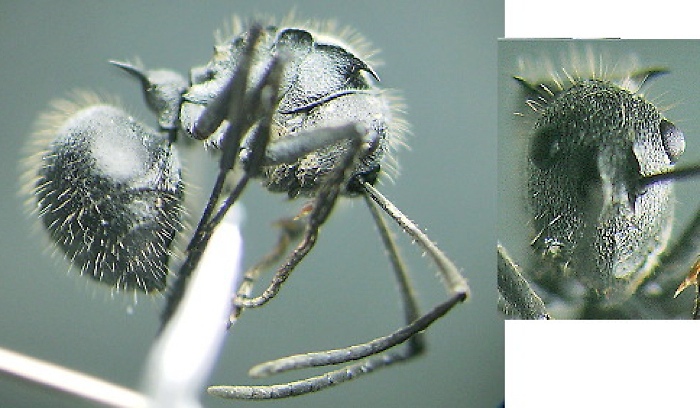 |
| Polyrhachis viscosa F Smith | Medium-sized ant, TL 5.9-7.6 mm Common pan-African savannah species; ground-nesting but known to forage on trees and bushes Six findings all with single figures for specimens; two on Vachellia nilotica (Trees 5/63 & 5/64); two on Combretum molle (Trees 3/64 & 3/65); one on Lannea schweinfurthii (Tree 3/67); and, one on Terminalia brownii (Tree 3/68) |
 |
|
Subfamily Myrmicinae |
||
| Cataulacus huberi André | Medium-sized ant, TL 5.5-7.8 mm First report from Tanzania; almost all prior reports are from West Africa and the Congo Basin, with one from Uganda Single specimen found on Heywoodia lucens (Tree 3/50) |
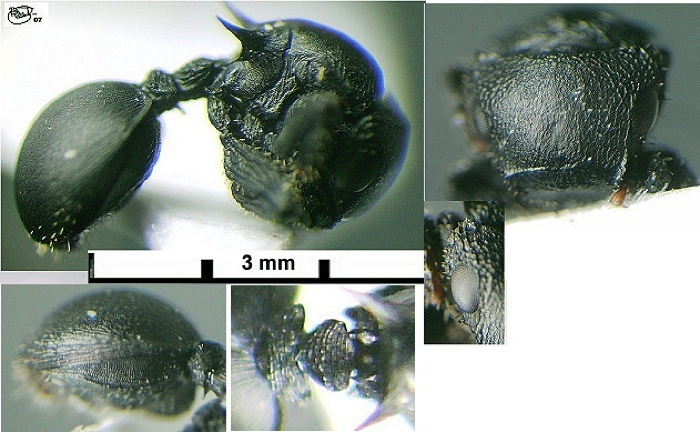 |
| Cataulacus impressus Bolton | Worker known solely from holotype from Uganda; a single male from Vachellia nilotica (Tree 5/55) appears to match the worker in general sculpturation and colouration | 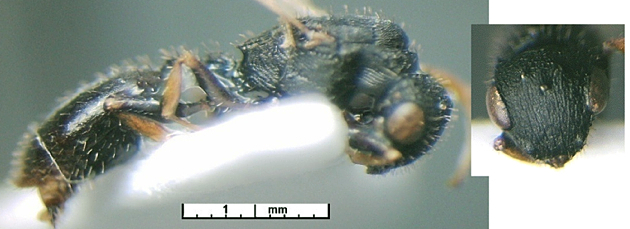 |
| Cataulacus intrudens F Smith | Medium-sized ant, TL 4.3-5.1 mm Widespread in Eastern Africa, from Somalia south to South Africa; this appears to match a described Tanzania variant of a "very variable species" Five findings; two on Lannea schweinfiurthi (Trees 3/66 & 3/67); two on Vachellia nilotica (Trees 5/55 & 5/63); and, one on Grewia sp (Tree 2/15); in low numbers |
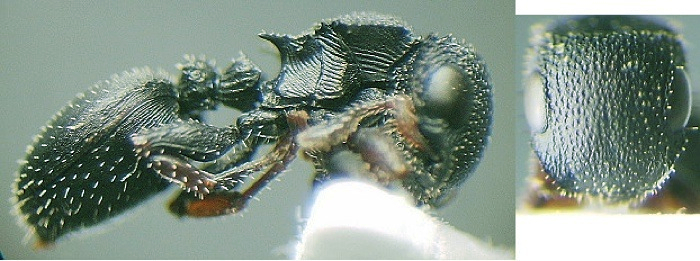 |
| Cataulacus kenyensis (Santschi) | Small ant, TL 3.6 mm First record from Tanzania, type collection from Nairobi, Kenya Four findings; three on Vachellia zanzibarica (Trees 5/17, 5/26 & 5/28), one with many specimens; one on Vachellia nilotica (Tree 5/63), single specimen |
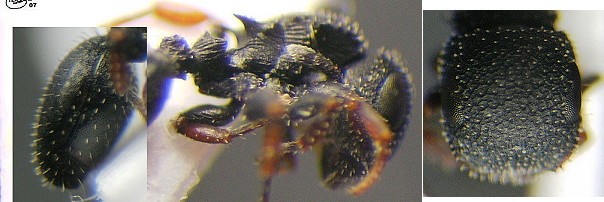 |
| Crematogaster (Cr.) acaciae Forel | Small ant, TL 3-5 mm Widespread but apparently uncommon in Eastern Africa, from Somalia south to South Africa; first report from Tanzania Single finding, 2 specimens, on Heywoodia lucens (Tree 3/50) |
 |
| Crematogaster (Cr.) gallicola Forel | Small ant, TL 2.2-3 mm First report from Tanzania; four known reports from Somalia south to South Africa Two findings; one on Combretum molle (Tree 2/18), 2 specimens; one on Lannea schweinfurthii (Tree 3/67) numerous specimens |
 |
| Crematogaster (Cr.) mimosae Santschi | Fairly small ant, TL 3.5-4.5 mm First report from Tanzania; type location Kenya, lower Mount Kenya in galls of Vachellia farnesia stenocarpa;, also known from Somalia and Ethiopia Six findings; five as a dominant on Vachellia zanzibarica (Trees 5/16, 5/17, 5/26, 5/27 & 5/28); one of two specimens on Ochna holstii (Tree 3/56) |
 |
| Crematogaster (Cr.) nigriceps Emery | Fairly small ant, TL 3-3.5 mm Several reports from Tanzania north to Ethiopia and type location Somalia, from acacia spines Four findings, all as a dominant on Vachellia drepanolobium (Trees 5/58, 5/59, 5/60 & 5/61) |
 |
| Crematogaster (Cr.) rauana (Forel) | Small ant, TL 2.7-3.0 mm new status; sole prior report as a variety of gallicola was from Tanzania; near Moshi Single specimen found on Heywoodia lucens (Tree 3/51) |
 |
| Crematogaster (Cr.) senegalensis Roger | Widespread Sahel species but first report from
Tanzania. Two findings on Heywoodia lucens (Trees 3/50 & 3/51); one specimen on each |
 |
| Fairly small ant, TL 3.0-5.5 mm Widespread in Eastern Africa, from Somalia south to South Africa; type location is Tanzania, Usambara Three findings, probably as a dominant; two on Combretum molle (Trees 2/25 & 2/31); one on Terminalia brownii (Tree 3/68) |
 |
|
| Crematogaster (Cr.) tricolor Gerstäcker | Fairly small ant, TL 4.2-4.8 mm Restored species status; widespread in Eastern Africa, from Somalia south to Mozambique; this possibly matches the described Tanzania variant bruta Two findings; one as a possible dominant on Lannea schweinfurthii (Tree 3/66); one of 25 specimens on Grewia sp (Tree 2/15) |
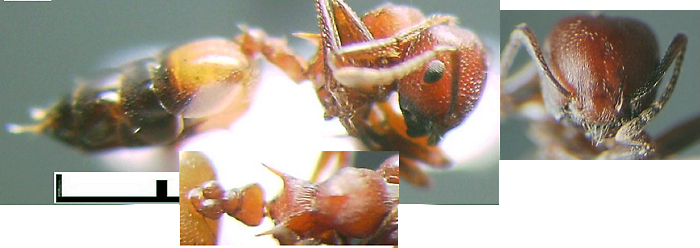 |
| Crematogaster (Decacrema) solenopsides Emery | Small ant, TL 2.25 mm Type location Tanzania, subspecies flavida type location was Usambara in Acacia galls Four findings; three of 4-49 specimens on Vachellia nilotica (Trees 5/55, 5/56 & 5/57); one of a single specimen on Combretum molle (Tree3/65) |
 |
| Crematogaster (Sphaerocrema) amita (Forel) | Fairly small ant, TL 3.4-3.5 mm First report from Tanzania. Two findings, both on Combretum molle (Trees 3/64 & 3/65), 4 & 2 specimens |
 |
| Crematogaster (Sphaerocrema) kneri Mayr | Fairly small ant, TL 4.2-4.8 mm First report from Tanzania; type location Zimbabwe, other reports from Angola. Three findings; one on Vachellia nilotica (Tree 5/55), 2 specimens; two on Combretum molle (Trees 2/26 & 2/27) ca 25 specimens on each |
 |
| Monomorium pallidipes (Forel) | Minute ant, TL 1.5 mm Type location Eritrea, other reports from Sudan, Kenya and Tanzania (Kilimanjaro) Four findings; three on Vachellia nilotica (Trees 5/55, 5/63 & 5/64 - 11 specimens); one on Grewia sp (Tree 2/15), 1 specimen |
 |
| Monomorium speluncarum (Santschi) | Minute ant, TL 1.5 mm First record from Tanzania; holotype & 2 other workers known only from a single site in Kenya Single finding of four specimens on Heywoodia lucens (Tree 3/50) |
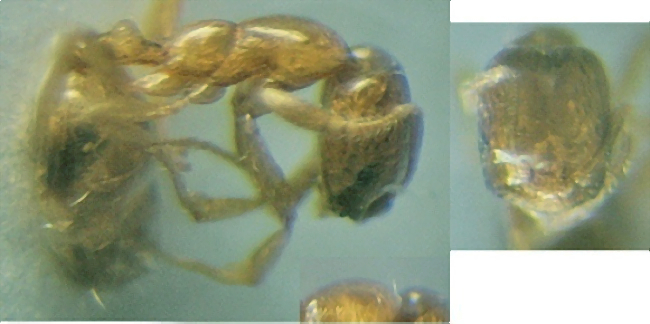 |
|
Nesomyrmex latinodis (Mayr) |
Small ant, TL 3.1-3.8 mm new status, type location Mozambique Widespread sub-Saharan form that seems wrongly lumped with the Egypt/North Africa type N. angulatus by Bolton Ten findings of 1-7 specimens; five on Vachellia nilotica (Trees 5/55, 5/56, 5/57, 5/63 & 5/64), two on Combretum molle (Trees 2/18 & 2/31); two on Lannea schweinfurthii (Trees 3/66 & 3/67); and, one on Terminalia brownii (Tree 3/68) |
 |
| Tetramorium caldarium (Roger) | Small ant, TL 2.1-2.4 mm First report from Tanzania; tramp species with African records including Kenya Three findings of 1-2 specimens each; two on Vachellia nilotica (Trees 5/56 & 5/63); and one on Heywoodia lucens (Tree 3/50) |
 |
| Tetramorium candidum Bolton | Small ant, TL 3.1-3.3 mm First report from Tanzania; single previous record from Type location in eastern Zaïre, Bukavu Single finding of 1 specimen on Heywoodia lucens (Tree 3/50) |
 |
|
Subfamily Pseudomyrmecinae |
||
| Tetraponera ambigua (Emery) | Fairly small ant, TL 4.5 mm First report from Tanzania; known from Ethiopia south to South Africa Single finding of many specimens on Terminalia brownii (Tree 3/68) |
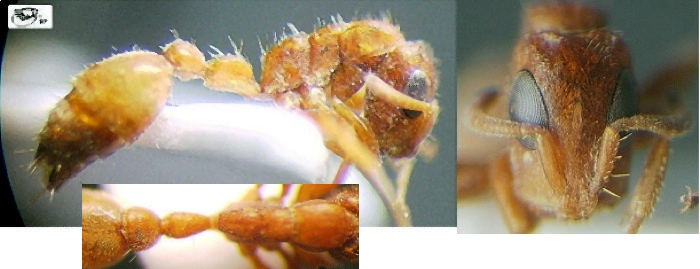 |
| Tetraponera bifoveolata (Mayr) | Fairly small ant, minor TL 3.8-4.2 mm, major TL
4.5-5.0 mm First findng of a major worker; type location Mozambique but known otherwise only from Tanzania and the Horn of Africa. Six findings; two on Acacia nilotica (Trees 5/63 & 5/64), many specimens & one queen; three on Vachellia zanzibarica (Trees 5/17, 5/26 & 5/28), 24, 3 & 7 specimens; plus a single specimen on Combretum molle (Tree 3/65) |
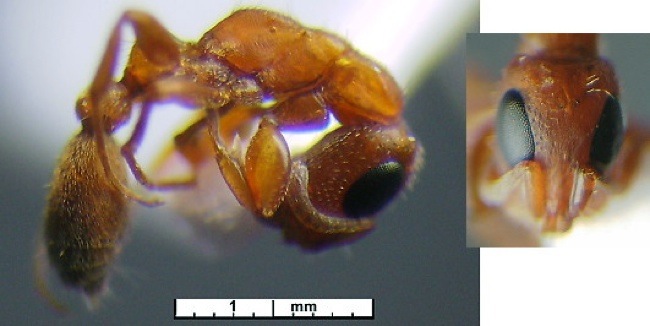 |
| Tetraponera parops Ward | Small ant ca 2.5 mm Reported without details from Kenya (type location), Tanzania and Somalia, collected in dead twigs Two findings of 14 and 19 specimens on Lannea schweinfurthii (Trees 3/66 & 3/67) |
 |
| Tetraponera prelli (Forel) | Medium-sized ant, TL 5.6-7.5 mm Type location Tanzania, Monga; also from Moshi and Usambara Five findings; two on Lannea schweinfurthii (Trees 3/66 & 3/67), 1 & 20 specimens; two on Combretum molle (Trees 2/25 & 3/64), 1 & 2 specimens; one on Vachellia nilotica (Tree 5/55), 11 specimens |
 |
Tree species
Vachellia drepanolobium Harms ex Sjöstedt - Whistling thorn acacia - gall species
Vachellia nilotica (L.) Willd. ex Del. (Leguminosae, subfamily Mimosoideae) is one of about 135 thorny African Acacia species. Variation is considerable with nine subspecies presently recognized, three occurring in the Indian subcontinent and six throughout Africa (Brenan 1983.) They are distinguished by the shape and pubescense of pods and the habit of the tree. Botany In habit A. nilotica varies from a shrubby tree with wide spreading crowns in savanna habitats (ssp. subalata, leiocarpa, adstringens, hemispherica and kraussiana), to a 20 meter tree (ssp. nilotica, tomentosa, and indica) in riverine situations. Ssp. cupressiformis has ascending branches like a poplar. Acacia nilotica is easy to recognize by its bright yellow flowers in round heads, straight stipular spines often slightly deflexed, and dark indehiscent pods compressed over the seeds. Flowering is prolific, and can occur a number of times in a season. Often only about 0.1% of flowers set pods (Tybirk 1989.) The taxa form a polyploid complex most are tetraploids (2n=4x=52); but higher numbers have been found in ssp. nilotica (2n=8x=104) & ssp. tomentosa (2n=16x=208) (Nongonierma 1976.) http://food-security.info/food-security.info/Winrock%20Archive/a_nilotica.html . A. nilotica subsp. kraussiana (Benth.) Brenan is the most common form in east tropical Africa including Botswana, Zambia, Rhodesia, Malawi, Tanzania, Angola, Mozambique, Transvaal, and Natal. also http://www.tropicalforages.info/key/Forages/Media/Html/Acacia_nilotica.htm
Vachellia zanzibarica (S. Moore) Taubert - gall species
Cobretum molle R.Br ex G - Common throughout Tanzania but more so within the coastal belt, in riverine forests, in wooded grasslands, and bushland. It is found on rocky sites and stony hills - http://www.fao.org/docrep/X5327e/x5327e0r.htm. Small to medium-sized deciduous tree. Leaves broadly elliptic, covered in grey velvety hairs on both surfaces, venation distinctly sunken above. Flowers in dense axillary spikes, greenish yellow, strongly scented. Fruit 4-winged, 1.5-2 c, in diameter, yellowish green, drying to reddish brown http://www.zimbabweflora.co.zw/speciesdata/species.php?species_id=141970
Dichrostachys cinerea (Linnaeus) R. Wight & Arnott - Grows in a variety of habitats: dry forests, woodlands, shrublands, open grassland, river banks, rocky hillsides, and coastal plains. Penetrates clear cut areas far into the rainforest zone. It is common in grasslands and on river banks in Arusha, Dodoma and Singida Shrub or small tree to 8 m tall. Branchlets densely to sparsely puberulous; lateral shoots to 8 cm long. Leaves: axes puberulous to minutely pilose, sometimes with red hairlets, especially near base of pinnae; glands peg-like at base of pinnae pairs; pinnae 2-11-jugate; leaflets 12-24-jugate, linear, obtuse to acute, straight to incurved, 2.5-4 (-6) mm long, 0.8-1.5 mm wide, ciliolate, otherwise glabrous. Inflorescence spicate, solitary on a bracteate, short shoot, 6-9 cm long including the glabrous to puberulous peduncle. Pod narrowly oblong, variously curved and/or coiled, 5-7 cm long, 8-15 mm wide, blackish, glabrous. Seeds biconvex, elliptic to subcircular, 4 mm long, 2-4 mm wide, pale tan, glossy; pleurogram elliptic" (Cowan, 1998; p. 19).
Heywoodia lucens Sim, Stink Ebony -
Lannea schweinfurthii (Engl.) Engl., False marula
Grewia sp. e.g G. occidentalis, (South Africa) it is a scrambling deciduous shrub or small tree reaching up to 3m in height. Purple star-shaped flowers (measuring 1.5 to 3cm across) appear in summer (October - January), followed by distinctive four-lobed fruits (hence the common name cross-berry and four-corner). Fruits turns shiny reddish-brown to light purple when ripe (January - May) and may remain on the tree for long periods. The leaves are alternate and simple with three distinct veins from the base. They are shiny deep green and may be slightly hairy on both surfaces. They are usually held in a horizontal plane towards the light.
Ochna holstii Engl. -
Terminalia brownii Fresen (photo from http://www.metafro.be/prelude/prelude_pic/Terminalia_brownii1.jpg) An often straight boled tree with a roundish crown, growing up to 15m, sometimes 25m tall. It grows in sub-humid woodland and savana; in drier areas as it is confined to the vicinity of rivers.
|
© 2007, 2008, 2009, 2011, 2012 - Brian Taylor CBiol FSB FRES 11, Grazingfield, Wilford, Nottingham, NG11 7FN, U.K. |
href="mkomazi_ants_2009.htm"